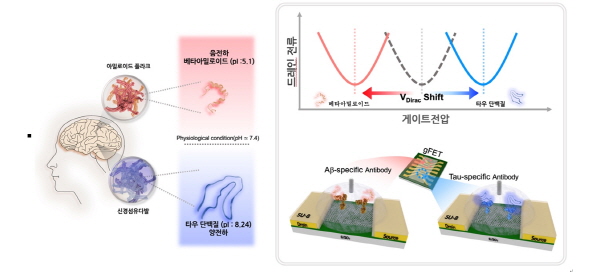Alzheimer's disease can be diagnosed with a drop of body fluid
Nano biosensor developed for multiplexed femtomolar detection of key biomarkers
Professor Yoon Dae-Sung 's team published a paper in Biosensors & Bioelectronics, one of the most authoritative journals in the field of biosensors

▲ (From left) Park Dong-sung, graduate student, and Professor Yoon Dae-sung, College of Health Science of Korea University; and Hwang Kyo-seon, College of Medicine of Kyung Hee University
A joint research team led by Professor Yoon Dae-sung of Korea University’s School of Biomedical Engineering of College of Health Science and Professor Hwang Kyo-seon of Kyung Hee University’s Medical School developed a highly sensitive nano-biosensor platform using graphene-based field-effect transistors that can simultaneously detect multiple biomarkers of Alzheimer's disease pathogenesis (amyloid-beta, tau) in blood and cerebrospinal fluids to a femtogram (10^(-15)g) sensitivity.
Park Dong-sung (first author, Department of Biomedical Engineering, Korea University), Professor Yoon Dae-sung (co-corresponding author, Department of Biomedical Engineering, Korea University), and Professor Hwang Kyo-seon(co-corresponding author, School of Medicine, Kyung Hee University) participated in this study as lead authors. The research results were published online on August 15 in Elsevier’s Biosensors & Bioelectronics (IF=10.257, ranked in the top 0.581% of the JCR category), one of the most authoritative journals in the field of electrochemistry and analytical chemistry.
* Title of paper : Multiplexed femtomolar detection of Alzheimer's disease biomarkers in biofluids using a reduced graphene oxide field-effect transistor
Alzheimer's disease is the most common neurodegenerative disease and responsible for 70% of dementia cases. High concentrations of beta-amyloid* and hyperphosphorylated* tau protein* caused by neurodegeneration and genetic factors are known to be major hallmarks of the initial progress of Alzheimer's disease. Neuropsychological question-and-answer tests or positron emission tomography (PET)/magnetic resonance imaging (MRI) are currently used to diagnose Alzheimer’s disease. However, these methods are expensive and the diagnosis of the disease can be subjective. The National Institute on Aging and the Alzheimer's Association (NIA-AA) have recently recognized the importance of the detection of beta-amyloid and tau protein in biofluids in their guidelines for the diagnosis of Alzheimer's disease. As a result, the need for a sensor that can accurately analyze the biomarkers present in a few picograms (10-12g) of body fluid has substantially increased. In particular, field-effect transistor biosensors based on graphene, the dream material, have drawn growing attention thanks to their excellent electrical properties with high sensitivity and surfaces capable of antibody immobilization.
* Beta-Amyloid: The Alzheimer’s brain is found to have abnormal levels of amyloid plaques, which mainly consist of beta-amyloid (Aβ or Abeta). It refers to peptides of 36-43 amino acids that are defined as the key biomarkers of Alzheimer's disease. Beta-amyloid can exist in various forms such as monomers, oligomers, and fibers in the body, and misfolded oligomers are known to exhibit cytotoxicity and cause Alzheimer's dementia.
* Tau protein: As an intracellular microtubule-binding protein, it normally supports neuronal activity. When abnormally modified, however, it contributes to brain lesions such as Alzheimer's disease. Hyperphosphorylation of tau protein is often observed in the neurons of Alzheimer's patients.
* Hyperphosphorylation: This refers to a biochemical reaction in which a phosphate group is added to a serine or threonine in the amino acid sequence by tau protein kinase.
The research team focused on the fact that beta-amyloid and tau proteins, which are the major causative agents of Alzheimer's disease, have different surface charges depending on the physiological environment of body fluids (pH 7.4). Based on this idea, they developed a multiplexed detection platform using a graphene-based field-effect transistor* that emits a distinctive output signal for each biomarker. Most proteins or peptides have a positive or negative surface charge in the physiological environment based on their isoelectric point* (pI). For example, amyloid-beta with a 5.1 pl has a negative charge in an environment of pH 7.4 while tau protein with an 8.24 pl has a positive charge in the same environment. When the surface charge of a biomaterial attached to the surface of graphene-based field effect transistors has a positive or negative charge, the electrical properties of the graphene is also affected correspondingly. Using this property, the research team succeeded in the multiplexed detection of beta-amyloid and tau proteins in cerebrospinal fluid and blood to the femtomolar-level.
* Isoelectric point: The pH at which a molecule is in a neutral state, that is, without an electrical charge. Proteins have a positive charge at pHs lower than their isoelectric point, and negative charges at pHs higher than their isoelectric point./span>
* Graphene-based field effect transistor: It refers to a device manufactured by applying graphene in the form of a thin carbon film, a typical nanomaterial, to the gate of a field effect transistor, which is a general semiconductor device. It can be used as a biosensor that provides binding sites for the immobilization of antibodies on the surface of graphene.
Professor Yoon said, “Based on the research results, we are currently working with Professor Lee Jin-san of the Department of Neurology at Kyung Hee University Hospital for clinical trials analyzing the concentrations of beta-amyloid and tau proteins in the clinical blood and saliva samples of patients and healthy individuals and estimating their risk of Alzheimer’s disease." He also stressed, “The graphene-based nano-biosensor that we have developed is a platform technology, and, therefore, it can also be applied to the diagnosis of other diseases. In other words, it is not limited to the detection of Alzheimer's disease biomarkers only. Thus, thanks to its potential for accurate disease diagnosis through surface charge analyses of the causative agents of different diseases (proteins, nucleic acids), the technology is expected to greatly contribute to applicable clinical studies.”
◈◈ Description of Figures ◈

▲ Figure 1. Schematic illustration of the graphene-based biosensor for multiplex detection

▲ Figure 2. Detection results of beta-amyloid and tau protein in buffer solution, cerebrospinal fluid, and plasma



